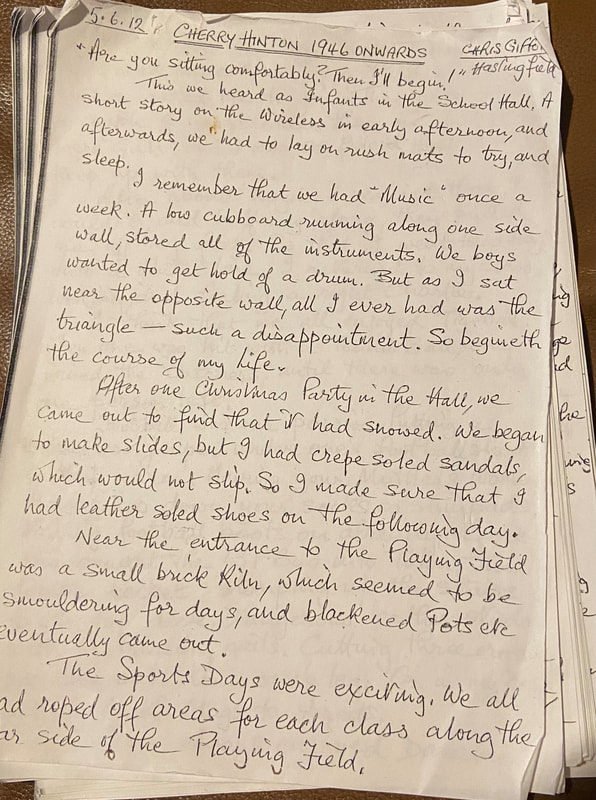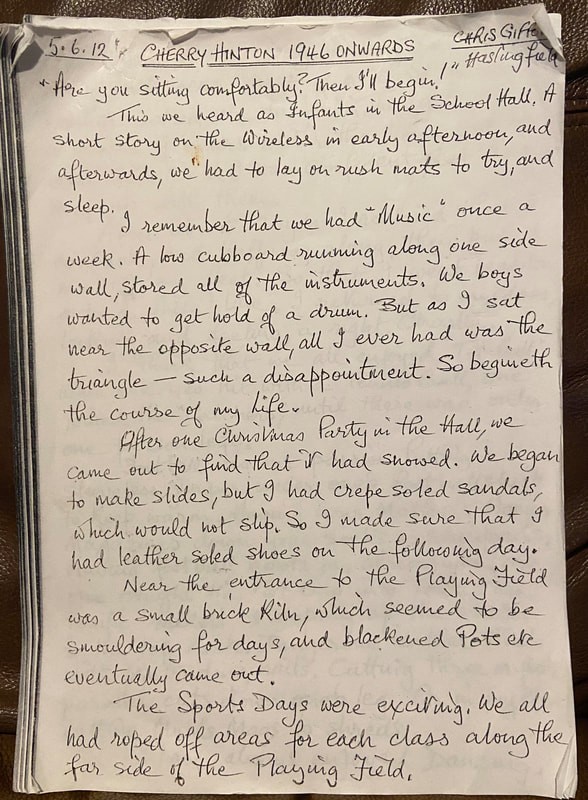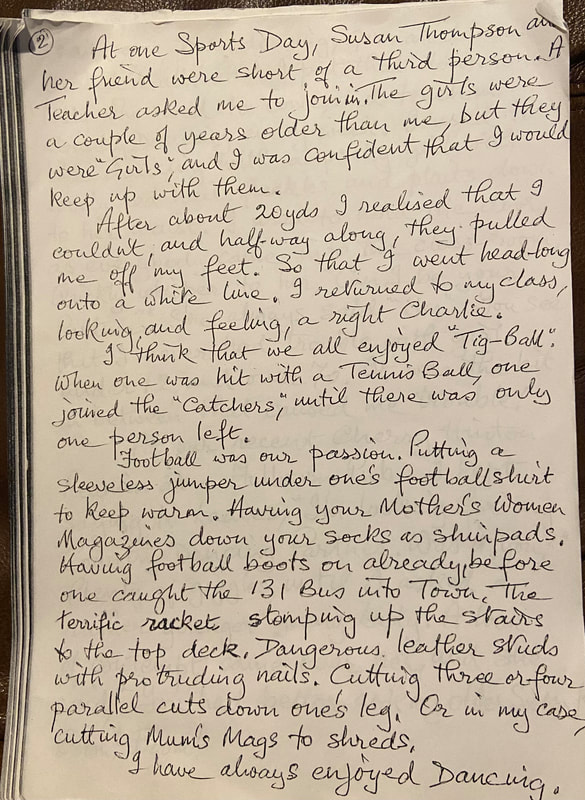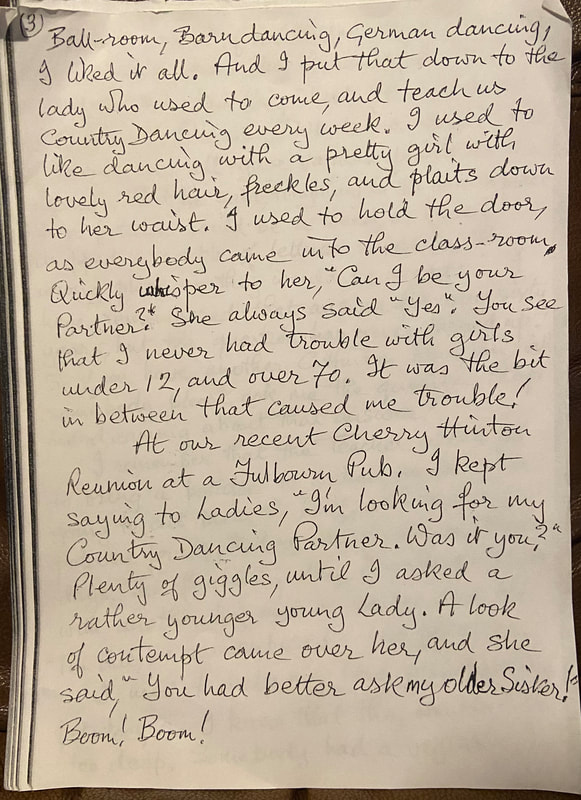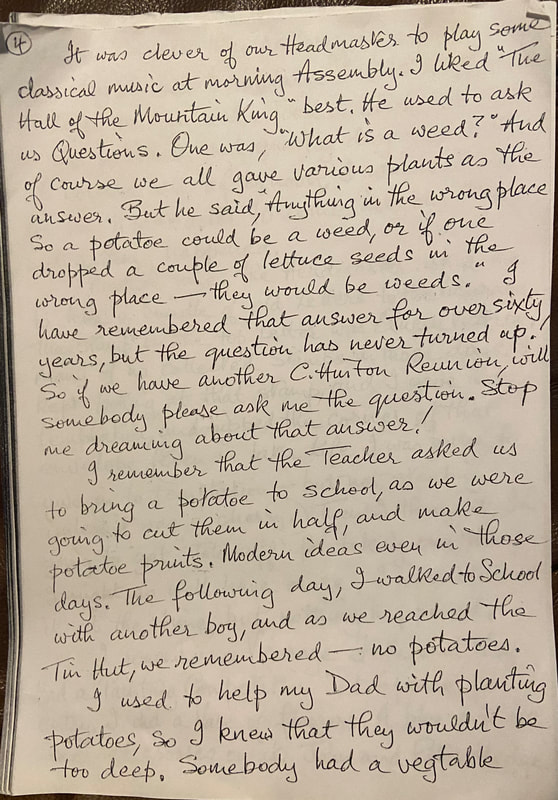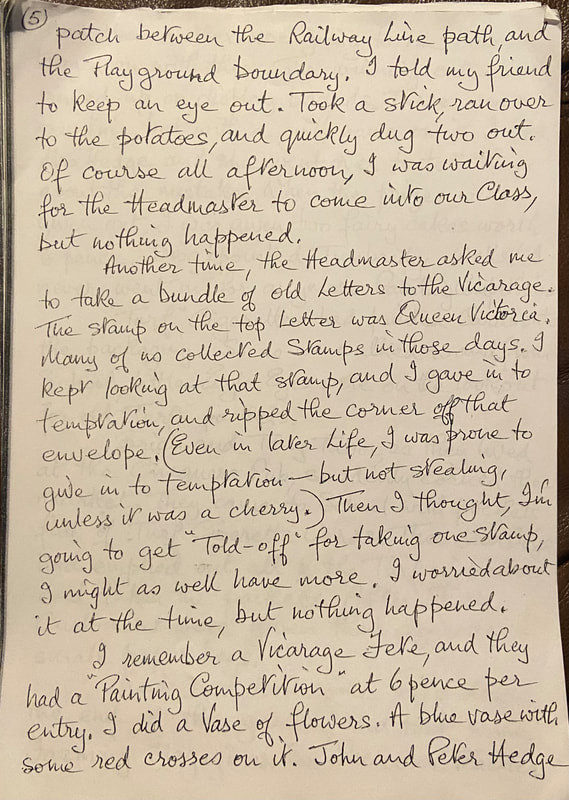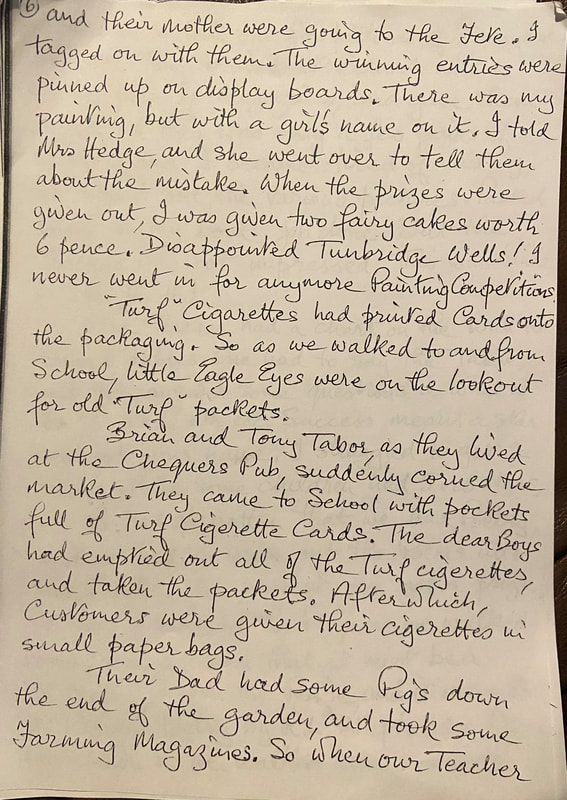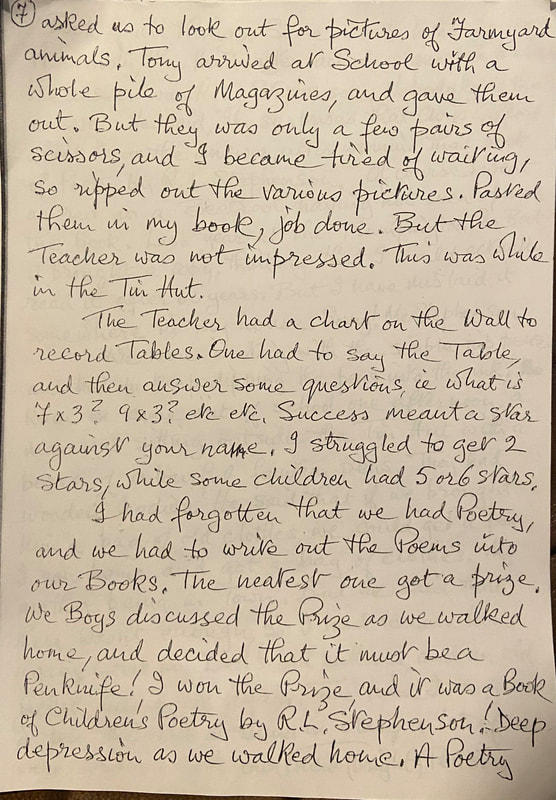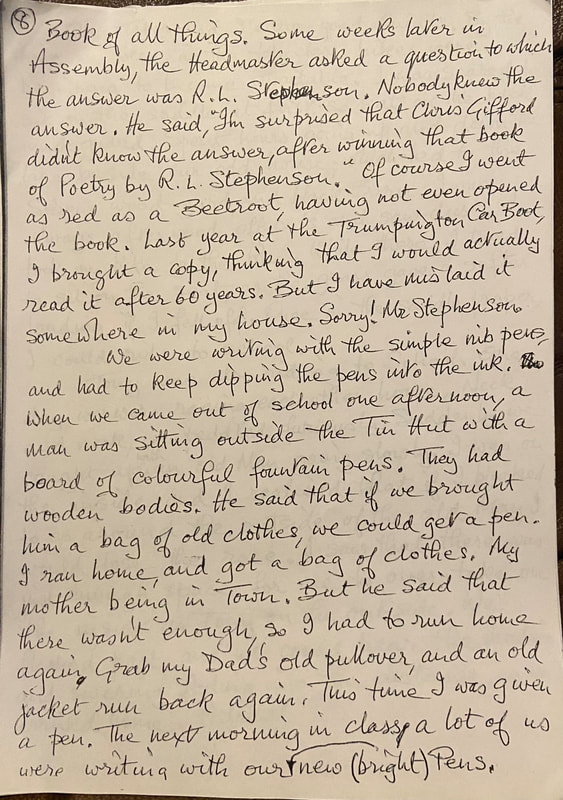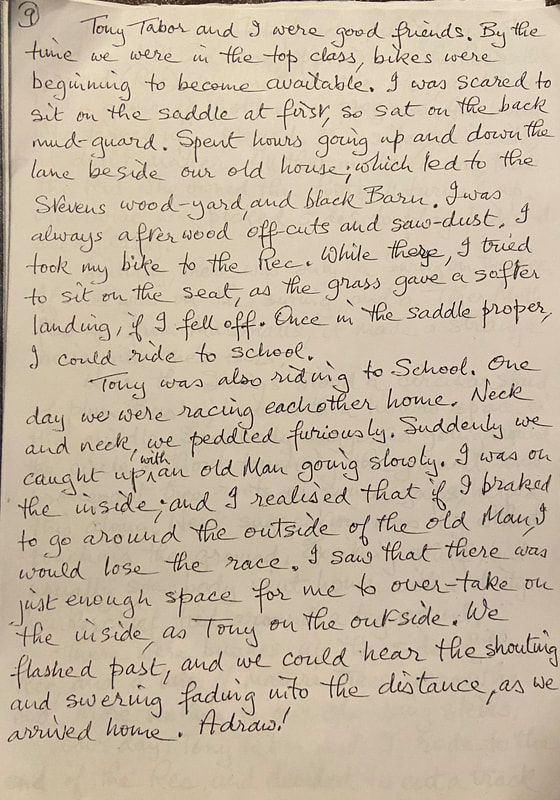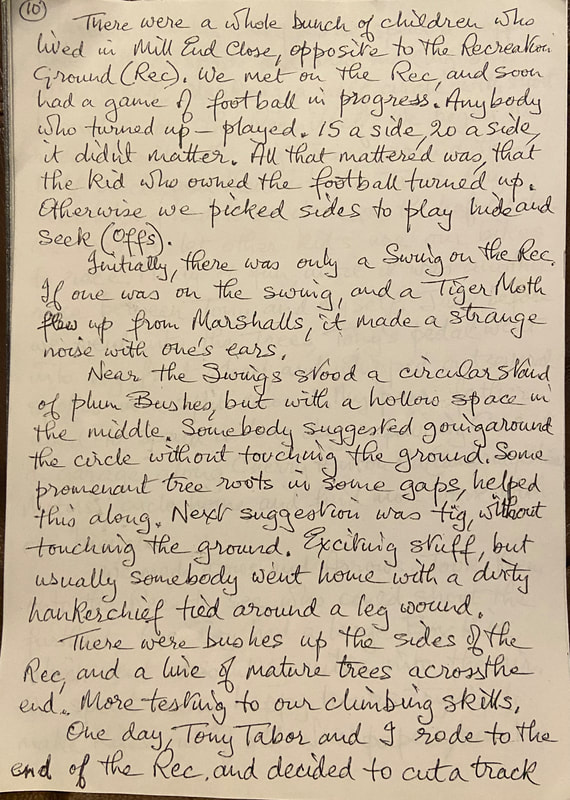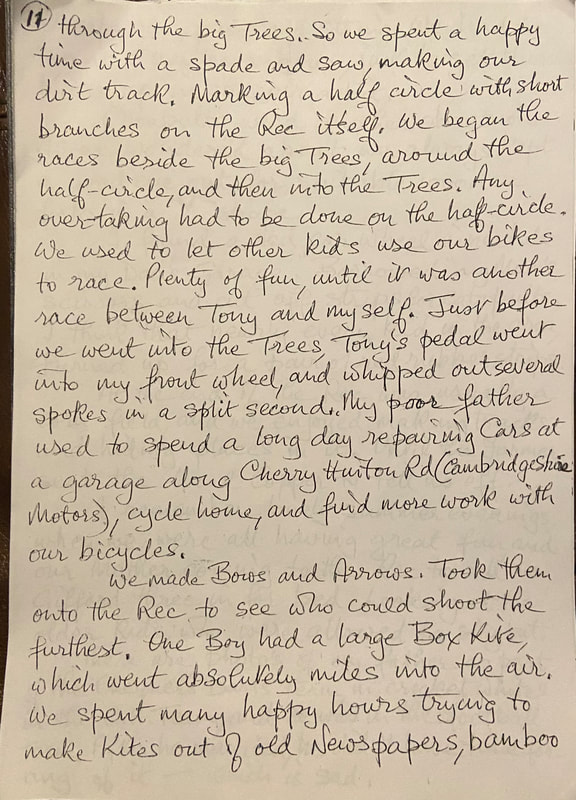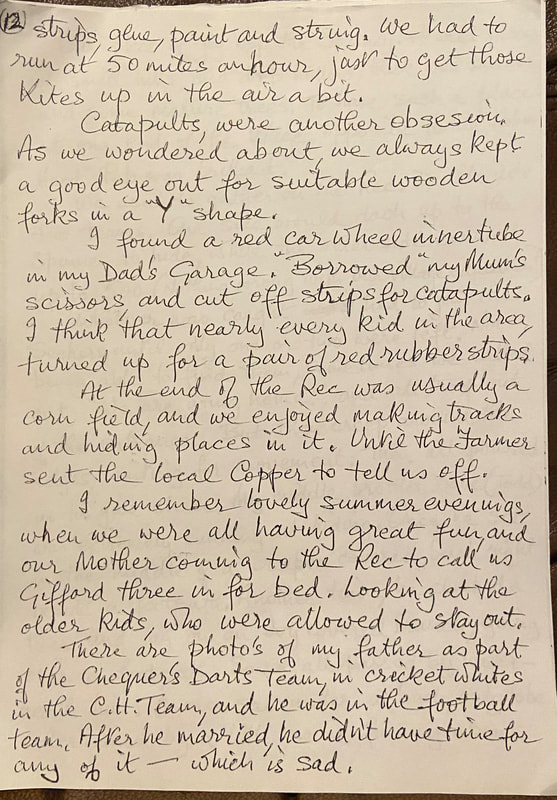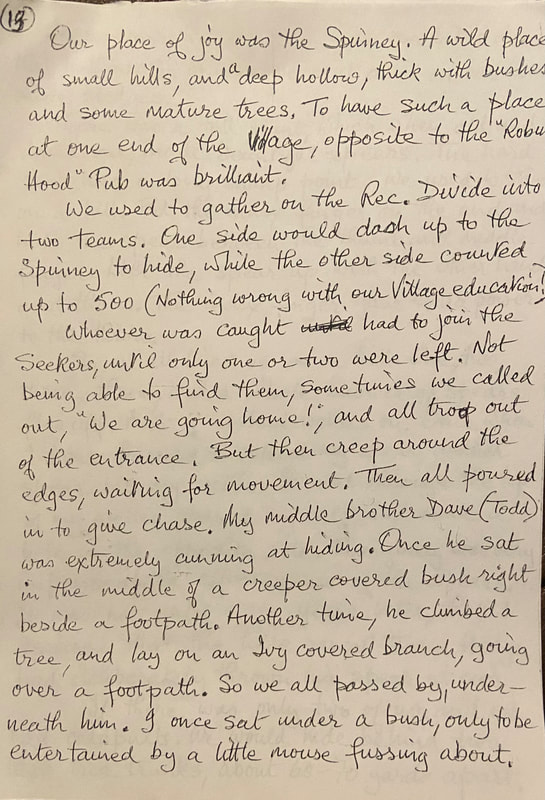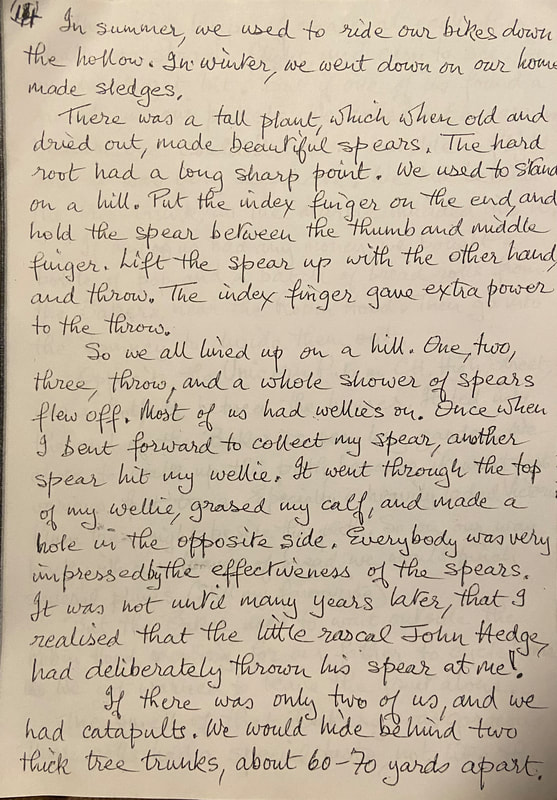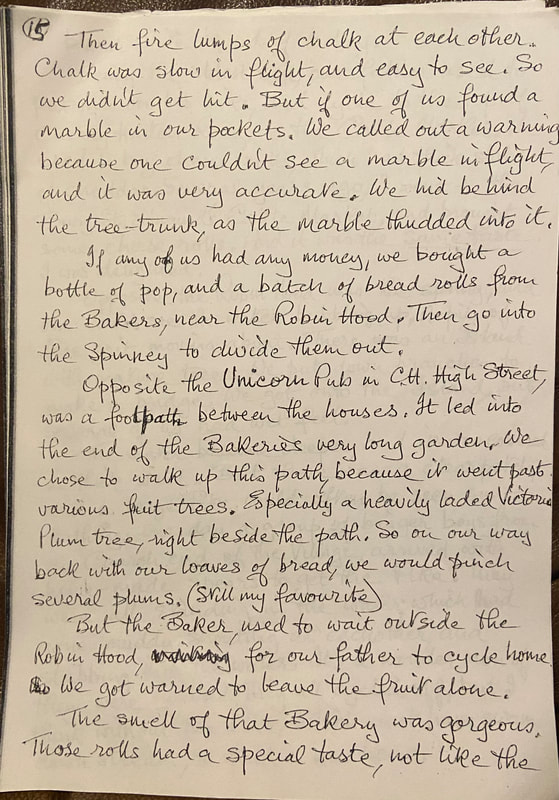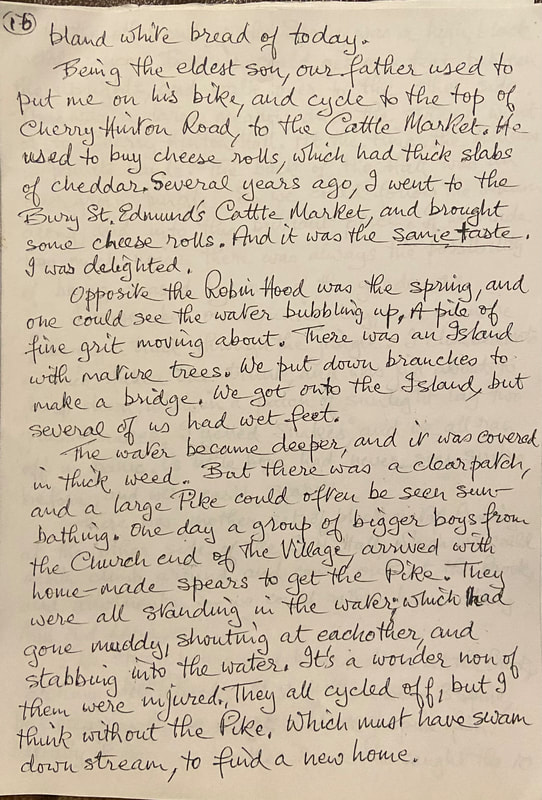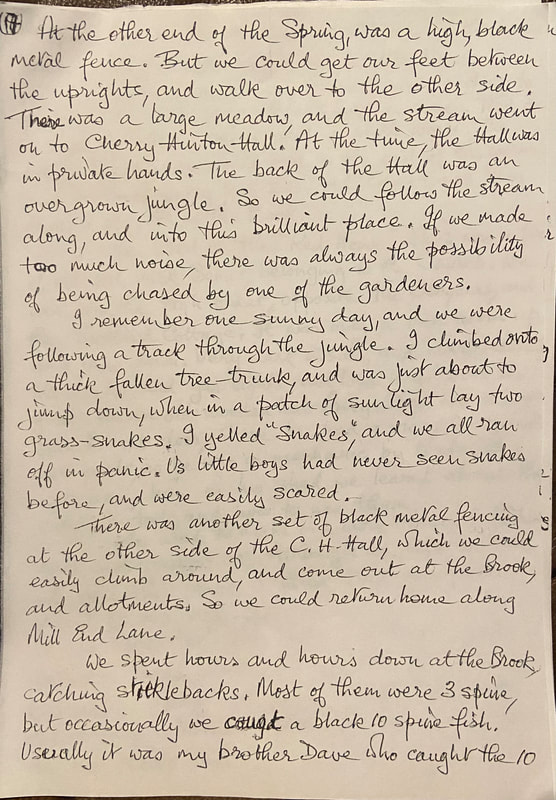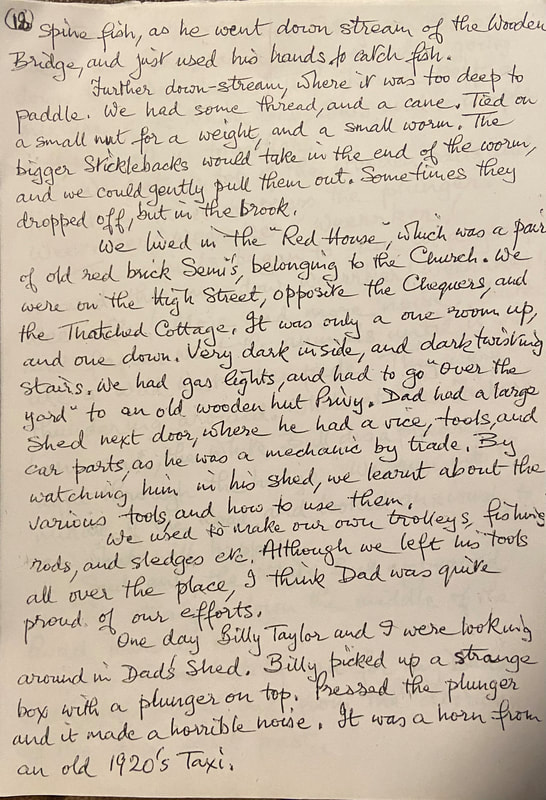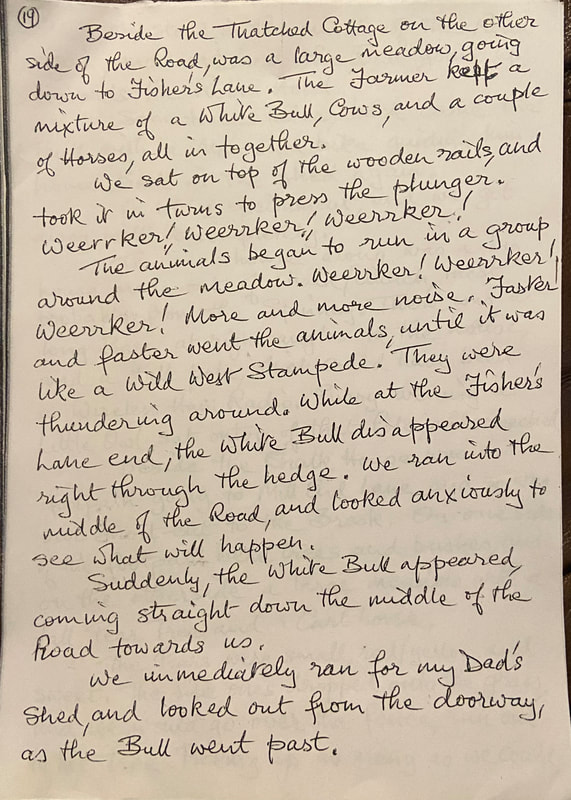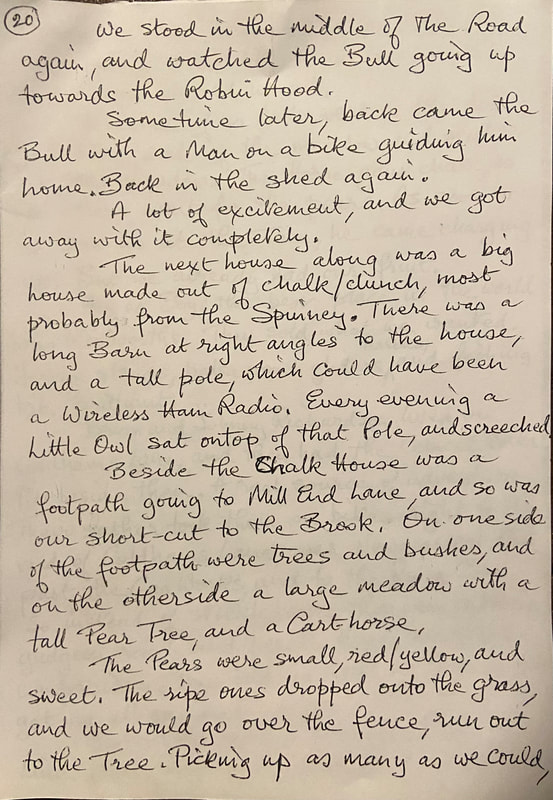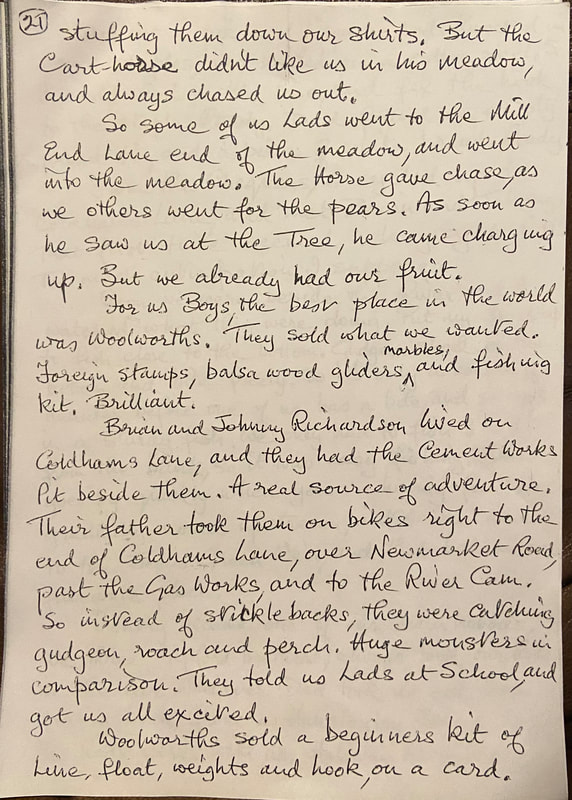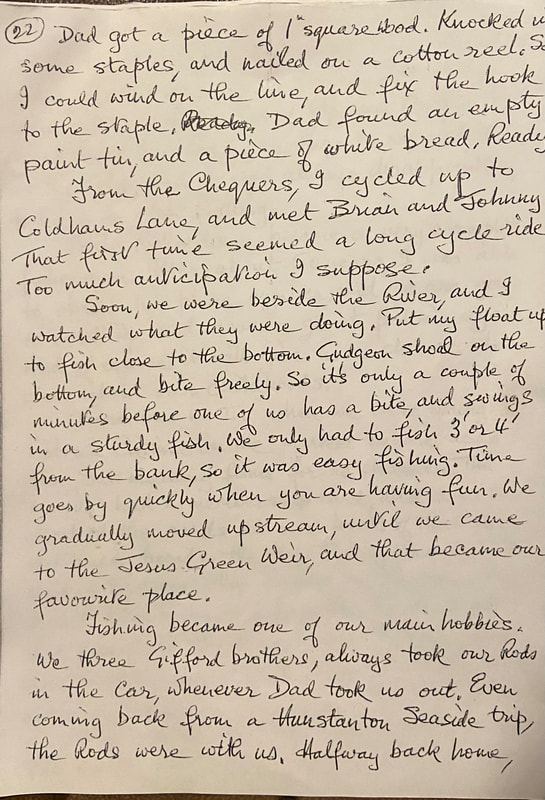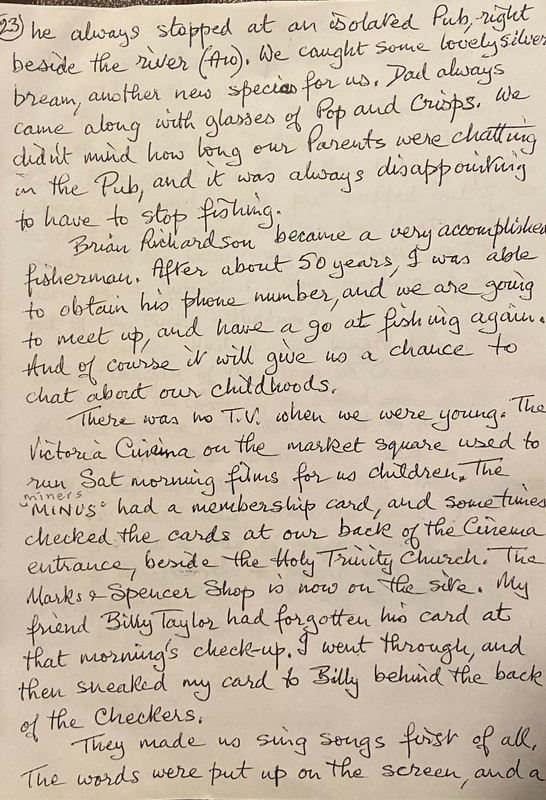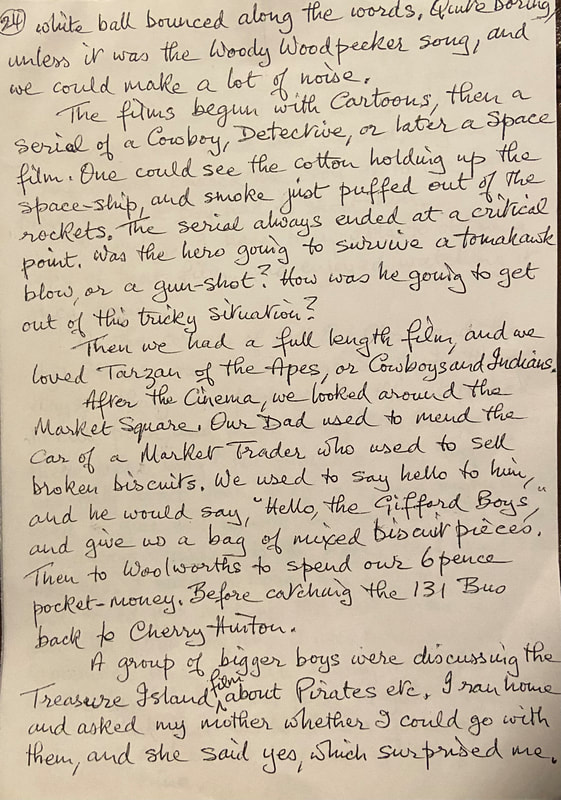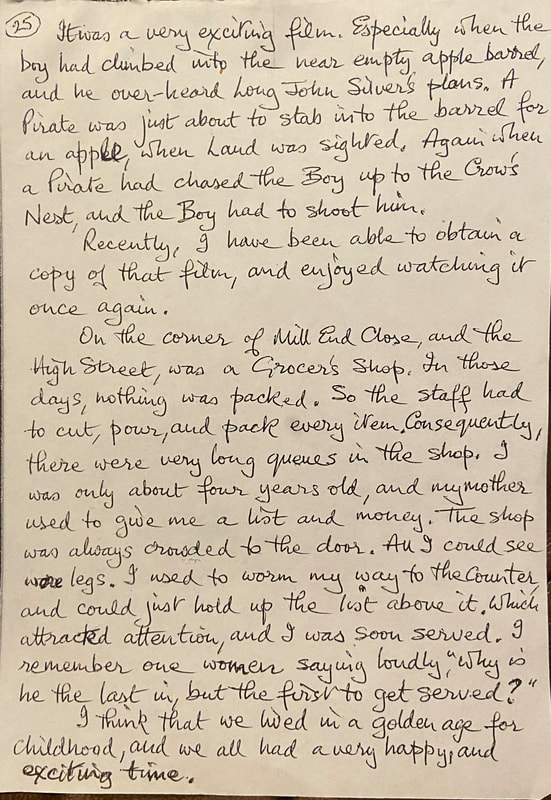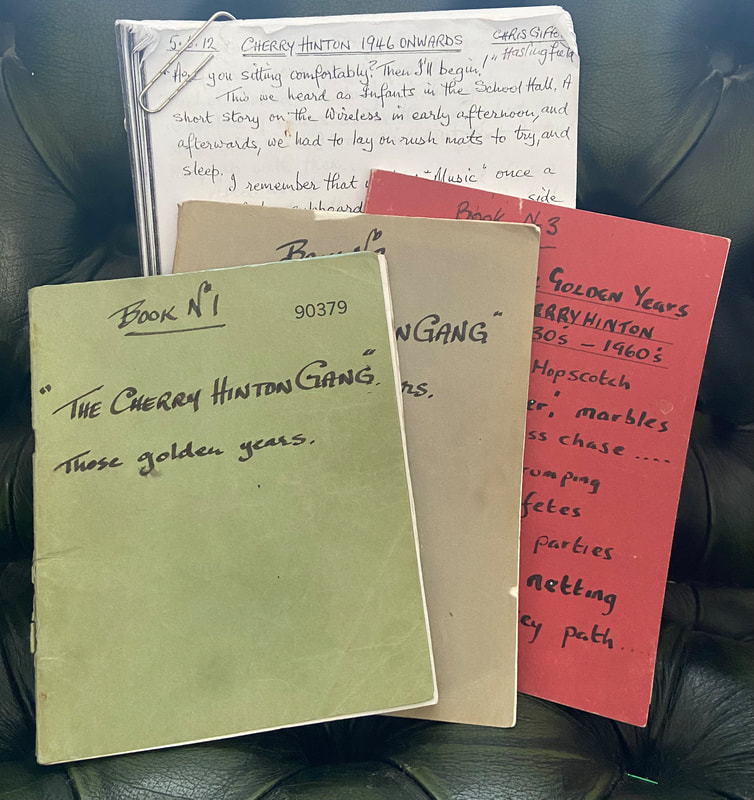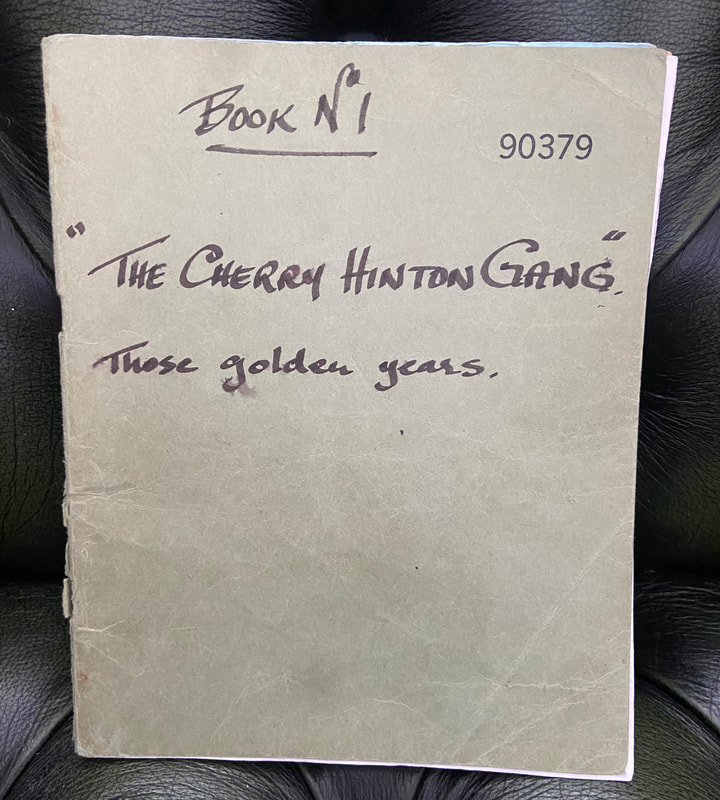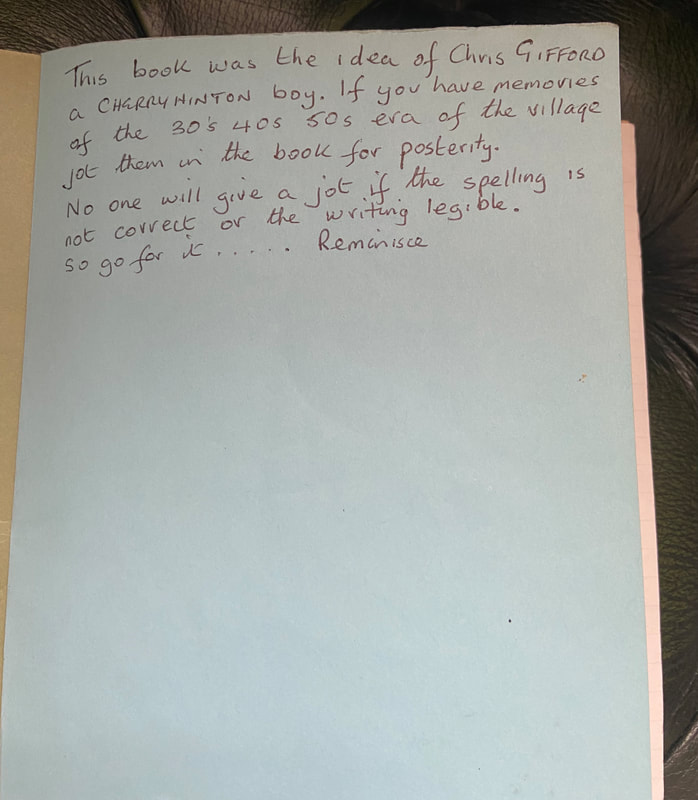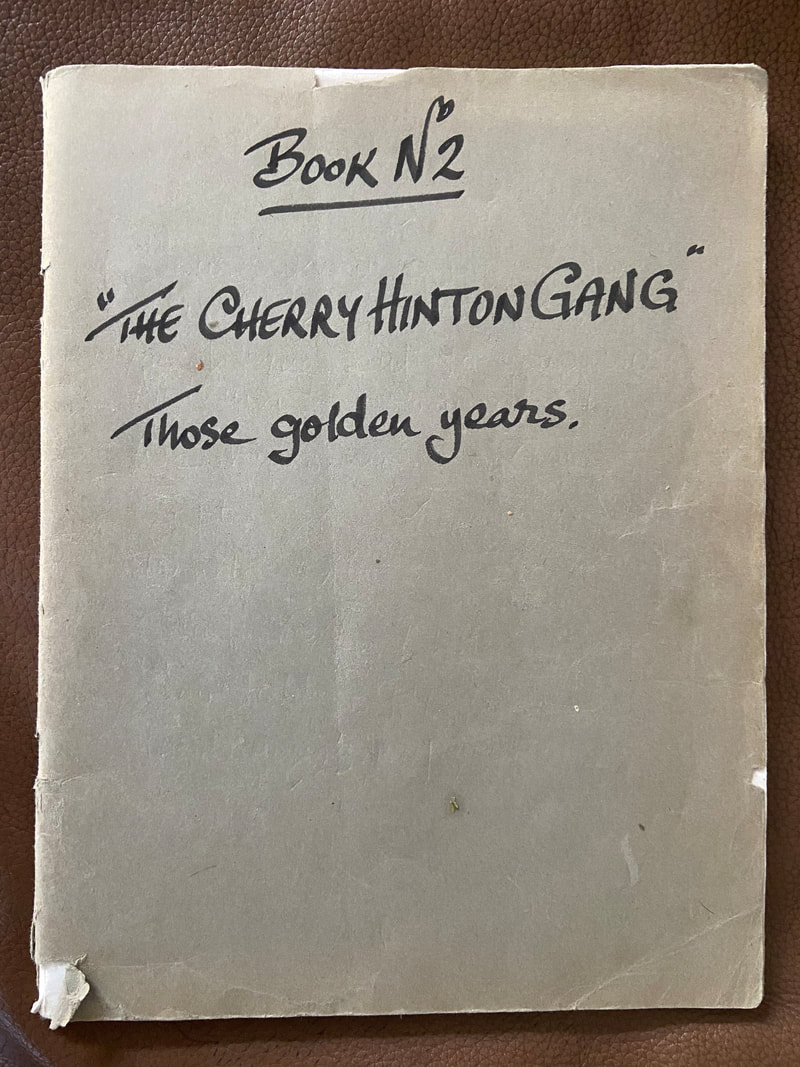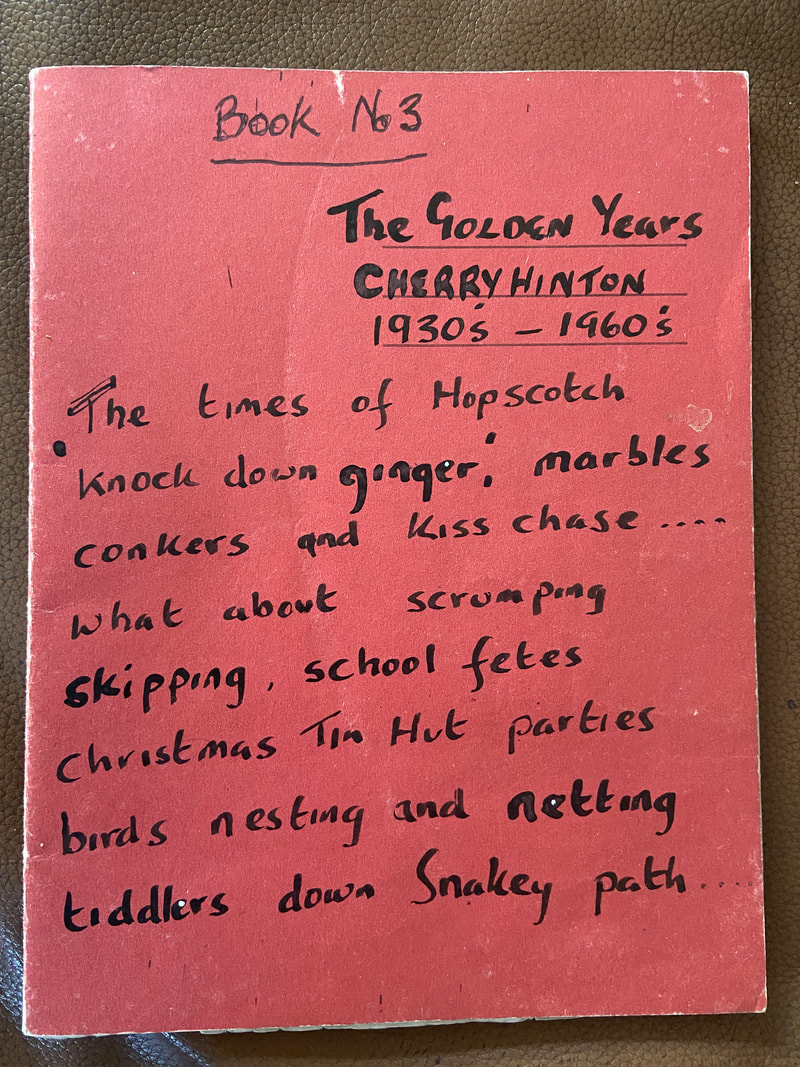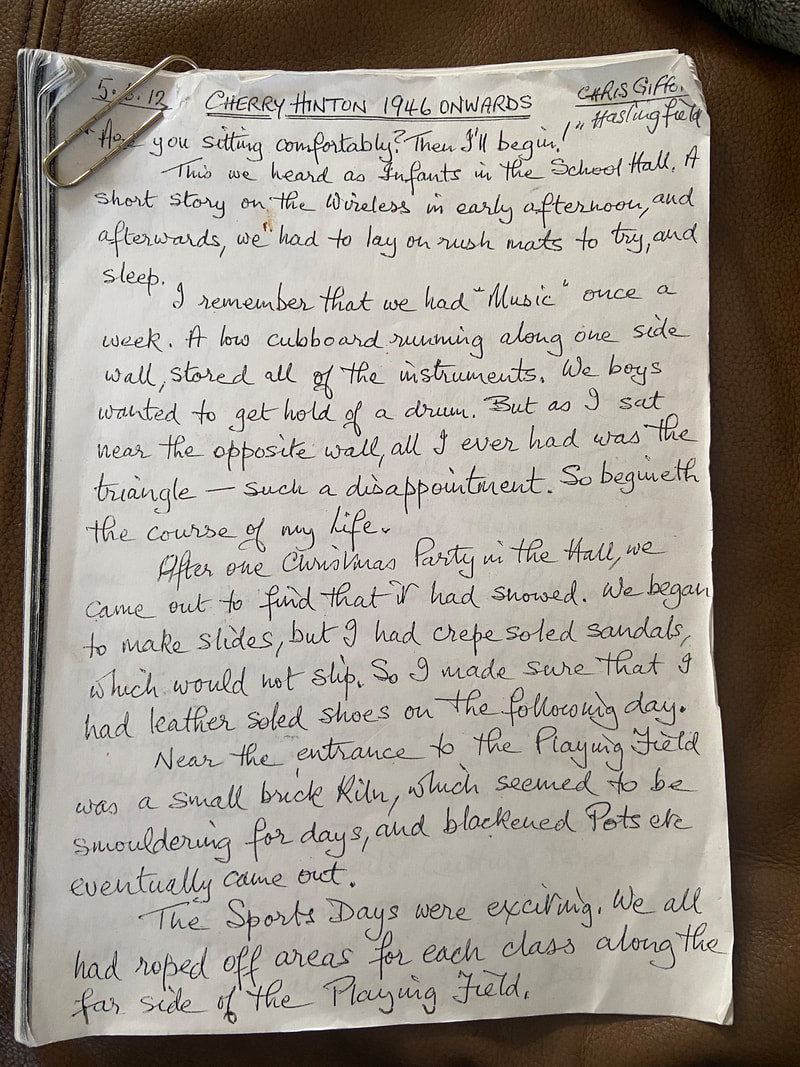|
Here you will find the complete article by Chris Gifford 'Cherry Hinton 1946 Onwards' - if you haven't done so already, I would encourage you to take a brief look at the introduction page about the memory books and this accompanying article first - which you can do by clicking the link here: Cherry Hinton Memory Books - Introduction
There are three books altogether and this one separately written article - you can find the links to the other books and this article by visiting the Cherry Hinton Memory Books Introduction page, mentioned above, or by searching the index (Categories) on the righthand side of this page or by using the search box on the right.
Cherry Hinton 1946 Onwards Chris Gifford 5.6.12
Chris Gifford Cherry Hinton Memories
“Are you sitting comfortably? Then I’ll begin!” This we heard as infants in the school hall. A short story on the wireless in early afternoon, and afterwards, we had to lay on rush mats to try and sleep. I remember that we had “Music” once a week. A low cupboard running down along one side wall, stored all of the instruments. We boys wanted to get hold of a drum. But as I sat near the opposite wall, all I ever had was the triangle – such a disappointment. So begineth the course for my life. After one Christmas Party in the Hall, we came out to find that it had snowed. We began to make slides, but I had crepe soled sandals which would not slip. So, I made sure that I had leather soled shoes on the following day. Near the entrance to the Playing Field was a small brick kiln, which seemed to be smouldering for days and blackened Pots etc eventually came out. The Sports Days were exciting. We all had roped off areas for each class along the far side of the Playing Field. At one Sports Day, Susan Thompson and her friend were short of a third person. A teacher asked me to join in. The girls were a couple of years older than me, but they were ‘girls’, and I was confident that I would keep up with them. After about 20yards I realised that I couldn’t, and half-way along, they pulled me off my feet. So that I went head-long onto a white line. I returned to my class, looking, and feeling, a right Charlie. I think that we all enjoyed “Tig-Ball”, when one was hit with a tennis ball, one joined the “catchers”, until there was only one person left. Football was our passion. Putting a sleeveless jumper under one’s football shirt to keep warm. Having your mother’s women magazines down your socks as shinpads. Having football boots on already, before one caught the 131 Bus into town. The terrific racket stamping up the stairs to the top deck. Dangerous leather studs with protruding nails. Cutting three or four parallel cuts down one’s leg. Or in my case cutting mums mags to shreds. I have always enjoyed dancing. Ballroom, Barn dancing, German dancing, I liked it all. And I put that down to the lady who used to come and teach us Country Dancing every week. I used to like dancing with a pretty girl with lovely red hair, freckles, and plaits down to her waist. I used to hold the door, as everybody came into the classroom. Quickly whisper to her, “Can I be your partner?” She always said “Yes”. You see that I never had trouble with girls under 12, and over 70. It was the bit in-between that caused me trouble! At our recent Cherry Hinton Reunion at a Fulbourn Pub. I kept saying to ladies, “I’m looking for my Country Dancing partner. Was it you?”. Plenty of giggles, until I asked a rather younger young lady. A look of contempt came over her, and she said, “You had better ask my older sisters!” Boom! Boom! It was clever of our Headmaster to play some classical music at morning Assembly. I liked “The Hall of Mountain King” best. He used to ask us questions. One was, “What is a weed?” And of course, we all gave various plants as the answer. But he said, “Anything in the wrong place. So, a potato could be a weed, or if one dropped a couple of lettuce seeds in the wrong place – they would be weeds.” I have remembered that answer for over sixty years, but the question has never turned up! So, if we have another C. Hinton Reunion, will somebody please ask me the question. Stop me dreaming about that answer! I remember that the teacher asked us to bring a potato to school, as we were going to cut them in half, and make potato prints. Modern ideas even in those days. The following day, I walked to school with another boy, and as we reached the Tin Hut, we remembered – no potatoes. I used to help my dad with planting potatoes, so I knew that they wouldn’t be too deep. Somebody had a vegetable patch between the railway line path and the playground boundary. I told my friend to keep an eye out. Took a stick, ran over to the potatoes, and quickly dug two out. Of course, all afternoon, I was waiting for the headmaster to come into our class, but nothing happened. Another time, the headmaster asked me to take a bundle of old letters to the Vicarage. The stamp on the top of the letters was Queen Victoria. Many of us collected stamps in those days. I kept looking at that stamp, and I gave into temptation, and ripped the corner off that envelope. (Even in later life, I was prone to give in to temptation – not stealing, unless it was a cherry). Then I thought, I’m going to get “told off” for taking one stamp, I might as well have more. I worried about it at the time, but nothing happened. I remember a Vicarage Fete, and they had a painting competition at 6 pence per entry. I did a vase of flowers. A blue vase with some red crosses on it. John and Peter Hedge and their mother were going to the fete. I tagged on with them. The winning entries were pinned up on display boards. There was my painting, but with a girl’s name on it. I told Mrs Hedge, and she went over to tell them the mistake. When the prizes were given out, I was given two fairy cakes worth 6 pence. Disappointed Tunbridge Wells! I never went in for anymore painting competitions. “Turf” cigarettes had printed cards onto the packaging. So, as we walked to and from school, little Eagle Eyes were on the lookout for old ‘Turf’ packets. Brian and Tony Tabor, as they lived at the Chequers Pub, suddenly cornered the market. They came to school with packets full of Turf cigarette cards. The dear boys had emptied out all of the Turf cigarettes and taken the packets. After which, customers were given their cigarettes in small paper bags. Then dad had some pigs down the end of the garden and took some farming magazines. So, when our teacher asked us to look out for pictures of farmyard animals. Tony arrived for school with a whole pile of magazines and gave them out. But there were only a few pairs of scissors, and I became tired of waiting, so ripped out the various pictures. Pasted them in my book, job done. But the teacher was not impressed. This was while in the Tin Hut. The teachers had a chart on the wall to record Tables. One had to say the table and then answer some questions, i.e. what is 7 x 3? 9 x 3? Etc etc. Success meant a star against your name. I struggled to get 2 stars, while some children had 5 or 6 stars. I had forgotten that we had poetry and we had to write out the poems into our books. The neatest one got a prize. We boys discussed the prize as we walked home and decided that it must be a penknife! I won the prize, and it was a book of children’s poetry by R.L. Stephenson! Deep depression as we walked home. A poetry book of all things. Some weeks later in Assembly, the Headmaster asked a question to which the answer was R.L. Stephenson. Nobody knew the answer. He said, “I’m surprised that Chris Gifford didn’t know the answer, after winning that book of poetry by R.L. Stephenson”. Of course, I went as red as a beetroot, having not even opened the book. Last year at the Trumpington car boot, I brought a copy, thinking that I would actually read it after 60 years. But I mislaid it somewhere in my house. Sorry! Mr Stevenson. We were writing with the simple nib pens and had to keep dipping the pens into the ink. When we came out of school one afternoon, a man was sitting outside the Tin Hut with a board of colourful fountain pens. They had wooden bodies. He said that if we brought him a bag of old clothes, we could get a pen. I ran home and got a bag of clothes. My mother being in Town. But he said that these weren’t enough, so I had to run home again, grab my dad’s old pullover and an old jacket, run back again. This time I was given a pen. The next morning in class a lot of us were writing with our bright, new pens. Tony Tabor and I were good friends. By the time we were in the top class, bikes were beginning to become available. I was scared to sit on the saddle at first, so sat on the back mud guard. Spent hours going up and down the lane beside our old house, which led to the Stevens wood-yard and black barn. I was always after wood off-cuts and saw-dust. I took my bike to the Rec. Whilst there, I tried to sit on the seat, as the grass gave a softer landing, if I fell off. Once in the saddle proper I could ride to school. Tony was also riding to school. One day we were racing each other home. Neck and neck, we peddled furiously. Suddenly we caught up with an old man going slowly. I was on the inside and I realised that if I braked to go around the outside of the old man, I would lose the race. I saw that there was just enough space for me to over-take on the inside as Tony on the out-side. We flashed past, and we could hear the shouting and swearing fading into the distance, as we arrived home. A draw! There were a whole bunch of children who lived in Mill End Close, opposite to the Recreation Ground (Rec). We met on the Rec and soon had a game of football in progress. Anybody who turned up – played. 15 a side, 20 a side, it didn’t matter. All that mattered was that the kid who owned the football turned up. Otherwise, we picked sides to play hide and seek (offs). Initially, there was only a swing on the Rec. If one was on the swing, and a Tiger Moth flew up from Marshalls, it made a strange noise with one’s ears. Near the swings stood a circular stand of plum bushes, but with a hollow space in the middle. Somebody suggested going around the circle without touching the ground. Some promenade tree roots in some gaps helped this along. Next suggestion was tig, without touching the ground. Exciting stuff, but usually somebody went home with a dirty handkerchief tied around a leg wound. There were bushes up the sides of the Rec and a line of mature trees across the end. More testing to our climbing skills. One day, Tony Tabor and I rode to the end of the Rec and decided to cut a track through the big trees. So, we spent a happy time with a spade and saw making our dirt track. Making a half circle with short branches on the Rec itself. We began the races beside the big trees, around the half-circle, and then to the trees. Any over-taking had to be done on the half-circle. We used to let other kids use our bikes to race. Plenty of fun, until it was another race between Tony and myself. Just before we went into the trees, Tony’s pedal went into my front wheel, and whipped out several spokes in a split second. My poor father used to spend a long day repairing cars at a garage along Cherry Hinton Road (Cambridgeshire Motors), cycle home, and find more work with our bicycles. We made bows and arrows. Took then onto the Rec to see who could shoot the furthest. One boy had a large box kite, which went absolutely miles into the air. We spent many happy hours trying to make kites out of old newspapers, bamboo strips, glue, paint and string. We had to run at 50 miles an hour just to get those kites up in the air a bit. Catapults were another obsession. As we wondered about, we always kept a good eye out for suitable wooden forks in a “Y’ shape. I found a red car wheel innertube in my dad’s garage. “Borrowed” my mum’s scissors and cut off strips for catapults. I think that nearly every kid in the area, turned up for a pair of red rubber strips. At the end of the Rec was usually a corn field, and we enjoyed making tracks and hiding places in it. Until the farmer sent the local Copper to tell us off. I remember lovely summer evenings when we were all having great fun and our mother coming to the Rec to call us Gifford three in for bed. Looking at the older kids, who were allowed to stay out. There are photos of my father as part of the Chequers Darts Team, in cricket whites in the Cherry Hinton Team, and he was in the Football Team. After he married, he didn’t have the time for any of it – which is sad. Our place of joy was the Spinney. A wild place of small hills and a deep hollow, thick with bushes and some mature trees. To have such a place at one end of the village, opposite the “Robin Hood” pub was brilliant. We used to gather on the Rec. Divide into two teams. One side would dash up to the Spinney to hide, while the other side counted up to 500 (nothing wrong with our village education!). Whoever was caught had to join the Seekers, until only one or two were left. Not being able to find them, sometimes we called out “We are going home!” and all troop out of the entrance. But then creep around the edges, waiting for movement. Then all poured in to give chase. My middle brother Dave (Todd) was extremely cunning at hiding. Once he sat in the middle of a creeper covered bush right beside a footpath. Another time, he climbed a tree and lay on an Ivy-covered branch, going over a footpath. So, we all passed by, underneath him. I once sat under a bush, only to be entertained by a little mouse fussing about. In summer, we used to ride our bikes down the hollow. In winter, we went down on our home-made sledges. There was a tall plant, which when old and dried out, made beautiful spears. The hard root had a long sharp point. We used to stand on a hill. Put the index finger on the end and hold the spear between the thumb and middle finger. Lift the spear up with the other hand, and throw. So, we all lined up on a hill. One, two, three, throw, and a whole shower of spears flew off. Most of us had wellies on. Once when I bent forward to collect my spear, another spear hit my wellie. It went through the top of my wellie, grazed my calf, and made a hole in the opposite side. Everybody was very impressed by the effectiveness of the spears. It was not until many years later, that I realised that the little rascal John Hedge, had deliberately thrown his spear at me! If there were only two of us and we had catapults, we would hide behind two thick tree trunks, about 60-70 yards apart. Then fire lumps of chalk at each other. Chalk was slow in flight and easy to see. So, we didn’t get hit. But if one of us found a marble in our pockets, we called out a warning because one couldn’t see a marble in flight, and it was very accurate. We hid behind the tree trunk, as the marble thudded into it. If any of us had any money, we bought a bottle of pop, and a batch of bread rolls from the bakers, near the Robin Hood. Then go into the Spinney to divide them out. Opposite the Unicorn Pub in C.H. High Street, was a footpath between the houses. It led into the end of the Bakeries very long garden. We chose to walk up this path, because it went past various fruit trees. Especially a heavily loaded Victoria Plumb tree, right beside the path. So, on our way back with our loafs of bread, we would pinch several plumbs. (Still my favourite). But the baker used to wait outside the Robin Hood, for our father to cycle home, we got warned to leave the fruit alone. The smell of that Bakery was gorgeous. Those rolls had a special taste, not like the bland white bread of today. Being the eldest son, our father used to put me on his bike, and cycle to the top of Cherry Hinton Road, to the Cattle Market. He used to buy cheese roll, which had thick slabs of cheddar. Several years ago, I went to the Bury St. Edmunds Cattle Market, and brought some cheese rolls and it was the same taste. I was delighted. Opposite the Robin Hood was the spring, and one could see the water bubbling up, a pile of fine grit moving about. There was an island with mature trees. We put down branches to make a bridge. We got onto the island but several of us had wet feet. The water became deeper, and it was covered in thick weed. But there was a clear patch, and a large Pike could often be seen sun-bathing. One day a group of bigger boys from the Church End of the village, arrived with home-made spears to get the Pike. They were all standing in the water, which had gone muddy, shouting at each other and stabbing the water. It’s a wonder none of them were injured. They all cycled off, but I think, without the Pike, which must have swam downstream to find a new home. At the other end of the spring was a high black metal fence. But we could get our feet between the uprights and walk over to the other side. There was a large meadow, and the stream went on to Cherry Hinton Hall. At the time the Hall was in private hands. The back of the Hall was an overgrown jungle. So, we could follow the stream along and into this brilliant place. If we made too much noise, there was always the possibility of being chased by one of the gardeners. I remember one sunny day, and we were following a track through the jungle. I climbed onto a thick fallen tree trunk and was just about to jump down, when in a patch of sunlight lay two grass snakes. I yelled “Snakes”, and we all ran off in panic. Us little boys had never seen snakes before and were easily scared. There was another set of black metal fencing at the other side of the C. H. Hall, which we could easily climb around and come out at the Brook and allotments. So, we could return home along Mill End Lane. We spent hours and hours down at the Brook, catching sticklebacks. Most of them were 3 spine but occasionally we caught a black 10 spine fish. Usually, it was my brother Dave who caught the 10 spine fish, as he went down the stream of the Wooden Bridge, and just used his hands to catch fish. Further down-stream, where it was too deep to paddle, we had some thread and a cane, tied on a small nut for a weight and a small worm. The bigger sticklebacks would take in the end of the worm, and we would gently pull them out. Sometimes they dropped off but in the Brook. We lived in the “Red House”, which was a pair of old red brick semi’s, belonging to the Church. We were on the High Street, opposite the Chequers, and the Thatched Cottage. It was only a one room up and one down. Very dark inside, and dark twisting stairs. We had gas lights and had to go “over the yard” to an old wooden hut privy. Dad had a large shed next door, where he had a vice, tools, and car parts, as he was a mechanic by trade. By watching him in his shed, we learnt about the various tools and how to use them. We used to make our own trolleys, fishing rods, and sledges etc. Although we left his tools all over the place, I think dad was quite proud of our efforts. One day, Billy Taylor and I were looking around in dads shed. Billy picked up a strange box with a plunger on top. Pressed the plunger and it made a horrible noise. It was a horn from an old 1920’s Taxi. Beside the Thatched Cottage, on the other side of the road, was a large meadow going down to Fishers Lane. The farmer kept a mixture of white bull, cows, and a couple of horses, all in together. We sat on top of the wooden rails and took it in turn to press the plunger. Weerrker! Weerrker! Weerrker! The animals began to run I a group around the meadow. Weerrker! Weerrker! Weerrker! More and more noise. Faster and faster went the animals, until it was like a wild west stampede. They were thundering around. While at the Fishers Lane end, the white bull disappeared right through the hedge. We ran into the middle of the road and looking anxiously to see what would happen. Suddenly, the white bull appeared, coming straight down the middle of the road towards us. We immediately ran for my dad’s shed, and looked out from the doorway, as the bull went past. We stood in the middle of the road again and watched the bull going up towards the Robin Hood. Sometime later, back came the bull with a man on a bike guiding him home. Back in the shed again. A lot of excitement and we got away with it completely. The next house along was a big house made out of chalk/clunch, most probably from the Spinney. There was a long barn at right angles to the house, and a tall pole, which could have been a wireless Ham Radio. Every evening a little owl sat on top of that pole and screeched. Beside the chalk house was a footpath going to Mill End Lane, and so was our short-cut to the Brook. One side of the footpath were trees and bushes, and on the otherside a large meadow with a tall pear tree and a carthorse. The pears were small, red/yellow and sweet. The ripe ones dropped onto the grass, and we would go over the fence, run out to the tree, picking up as many as we could, stuffing them down our shirts. But the carthorse didn’t like us in his meadow, and always chased us out. So, some of us lads went to the Mill End Lane end of the meadow, The horse gave chase, as we others went in for the pears. As soon as he saw us at the tree, he came charging up. But we already had our fruit. For us boys, the best place in the world was Woolworths. They sold what we wanted. Foreign stamps, balsa wood gliders, marbles, and fishing kit. Brilliant. Brian and Johnny Richardson lived on Coldhams Lane, and they had the Cement Works pit beside them. A real source of adventure. Their father took them on bikes right to the end of Coldhams Lane, over Newmarket Road, past the Gas Works and to the River Cam. So instead of sticklebacks, they were catching Gudgeon, Roach, and Perch. Huge monsters in comparison. They told us lads at school and got us all excited. Woolworths sold a beginner’s kit of line, float, weight and hook on a card. Dad got a piece of 1” square board, knocked in some staples, and nailed on a cotton reel, so I could wind on the line, and fix the hook to the staple. Dad found an empty paint tin, and a piece of white bread. Ready. From the Chequers, I cycled up to Coldhams Lane and met Brian and Johnny. That first time seemed a long cycle ride. Too much anticipation I suppose. Soon we were beside the river, and I watched what they were doing. Put my float up to fish close to the bottom. Gudgen shoal on the bottom and bite freely. So, it’s only a couple of minutes before one of us has a bite and swings in a sturdy fish. We only had to fish 3” or 4” from the bank, so it was easy fishing. Time goes by quickly when you are having fun. We gradually moved upstream until we came to the Jesus Green Weir, and that became our favourite place. Fishing became one of our main hobbies. We three Gifford brothers always took our rods in the car, whenever dad took us out. Even coming back from a Hunstanton seaside trip, the rods were with us. Halfway back home he always stopped at an isolated pub right beside the river (A10). We caught some lovely silver bream, another new species for us. Dad always came along with glasses of pop and crisps. We didn’t mind how long our parents were chatting in the pub, and it was always disappointing to have to stop fishing. Brian Richardson became a very accomplished fisherman. After about 50 years I was able to obtain his phone number and we are going to meet up and have a go at fishing again. And of course, it will give us a chance to chat about our childhoods. There was no T.V. when we were young. The Victoria Cinema on the Market Square used to run Sat morning films for us children. The “minors” had a membership card, and sometimes checked the cards at our back of the cinema entrance, beside the Holy Trinity Church. The Mark’s & Spencer shop is now on the site. My friend Billy Taylor had forgotten his card at that morning’s check-up. I went through, and then sneaked my card to Billy behind the back of the checkers. They made us sing songs first of all. The words were put up on screen, and a white ball bounced along the words. Quite boring, unless it was the Woody Woodpecker song, and we could make a lot of noise. The films begum with cartoons, then a serial of a cowboy, detective, or later a space film. One could see the cotton holding up the spaceship and smoke just puffed out of rockets. The serial always ended at a critical point. Was the hero going to survive a tomahawk blow, or a gun shot? How was he going to get out of this tricky situation? Then we had a full-length film, and we loved Tarzan of the Apes, or Cowboys & Indians. After the cinema, we looked around the Markey Square. Our dad used to mend the car of a market trader who used to sell broken biscuits. We used to say hello to him, and he would say “Hello, the Gifford Boys”, and give us a bag of mixed biscuit pieces. Then to Woolworths to spend our 6 pence pocket money. Before catching the 131 Bus back to Cherry Hinton. A group of bigger boys were discussing the Treasure Island film about Pirates etc. I ran home and asked my mother whether I could go with them, and she said yes, which surprised me. It was a very exciting film. Especially when the boy had climbed into the near empty apple barrel and he over-heard Long John Silver’s plan. A Pirate was just about to stab into the barrel for an apple, when land was sighted. Again, when a pirate had chased the boy up to the Crow’s nest, and the boy had to shoot him. Recently, I have been able to obtain a copy of that film and enjoyed watching it once again. On the corner of Mill End Close and the High Street was a Grocers shop. In those days, nothing was packed. So the staff had to cut, pour and pack every item. Consequently, there were very long queues in the shop. I was only about four years old, and my mother used to give me a list and money. The shop was always crowded to the door. All I could see were legs. I used to worm my way to the counter and could just hold up the list above it. Which attracted attention and I was soon served. I remember one woman saying loudly “why is he the last in but the first to get served?” I think that we lived in a golden age for childhood, and we all had a very happy and exciting time.
If you'd like to support the work that I do and the archive, why not buy me a virtual coffee, I'd be really grateful and it will help keep me going!
Just click on the green button below :)
1 Comment
In the autumn of 2021 I had a letter from a gentleman called Chris Gifford, who lives in a village close to Cambridge. He told me how, some years ago, he had written out a Cherry Hinton story from his memories of Cherry Hinton and had put it into an exercise book. He then went on to say...
“I showed it to another Cherry Hinton resident, and he wanted to write his stories. We were at Cherry Hinton Junior School in the 1940’s. The book was passed around from one to another all keen to write their stories! We have three books, and I continued with a 24 A4 pages of stories. One girl who lived in Mill End Close wrote about carrying her pet chicken to school. Upon reaching the railway line, she put it on the ground and told it to go home. Brilliant! Of course, there were few cars, and no stray dogs about” Chris offered me the collection of stories and notebooks to add to our Cherry Hinton archives, which I hold. We arranged a meeting, and I visited Chris in the village where he now lives. We had a very enjoyable time, as he related some of the tales from the books and then showed me around his village where he does such a lot to improve the surrounding natural areas using traditional skills. Chris then entrusted the collection of stories to me to make available for you all. There are three exercise books and one A4 written piece of 24 pages.
I will transcribe these tales individually and publish them here on the Cherry Hinton page. You will be able to find each complete book, once completed, under the link in the index menu on the right-hand side of the page or by following these links:
Cherry Hinton Memories Book One Cherry Hinton Memories Book Two Cherry Hinton Memories Book Three Cherry Hinton 1946 Onwards by Chris Gifford You can also click on the links below for each book/story. I will index the names, places and each story and each book individually too, which you can also find by looking down the right-hand side clickable menu on the main Cherry Hinton page or by using the search box on the right hand side. In addition, I will add any historical reference pictures that I have access to, to illustrate the tales within the individual stories. I am currently working on adding the pictures to each individual story. You will soon also be able to click on any of the names given below from each of these books to see individual stories or you can click on each book title to see the full collection of the stories within that book. Please feel free to use the 'Contact' button to get in touch if you spot any transcription errors (I'm only human!) - Please do ignore some general spelling and grammar issues as these stories are transcribed as they are written, in general - it's about preserving them as they are, as best is possible. There are, of course, some names or other words that I haven't quite been able to work out, which I would encourage you to drop me a note if you know what they should be so that they can be corrected. If you would like to add a memory or comment to any of the specific stories, then please do click the 'Comment' button at the end of each story. This will come through to me to approve and once approved it will show live in the comments section under the story on this site. Alternatively, if you would like to get in touch privately with any comments please use the 'Contact' button at the top of the pages which will result in me receiving an private email. Lastly, if you would like to add any of your own Cherry Hinton memories/pictures to the Cherry Hinton Archive and let me know using the 'Contact' button at the top of the page and let me know if you would like them published on this website too.
Book One “The Cherry Hinton Gang” Those Golden Years
Contains memories from: Mick Covill Bill Chapman Kay Smith Diana Lilley Ann Gentle Chris Kirch Gill Rapley Sue Gentle Ronnie Clark Tony Mason
Book Two “The Cherry Hinton Gang” Those Golden Years
Contains memories from: Bryan Stevens June Stevens Pat Clarke Julie Smith
Book Three “The Golden Years - Cherry Hinton, 1930's-1960's"
Contains memories from: Unknown Christine Wright Mavee Williams Malcolm Jobson Bett Dawson Stuart Nunn Neville Cullup Basil Simpkins Tony Tabor David Gifford Kenneth Gifford
Cherry Hinton 1946 onwards by Chris Gifford -separate written story on A4 paper.
If you'd like to support the work that I do and the archive, why not buy me a virtual coffee, I'd be really grateful and it will help keep me going!
Just click on the green button below :) |
Cherry Hinton History Pages:
Contents If you'd like to go straight to a specific article or blog post within the Cherry Hinton History Page you can click on any of the post titles in the list below and it will take you directly there. Alternatively, you can use the search box above to search by keyword or you can use the index further below. About & how to use:This is the blog page for my articles, memories and archives relating to the archaeology and local history of Cherry Hinton, a village to the southeast of Cambridge UK. The area covered is the old Parish of Cherry Hinton which today includes the Ward of Queen Edith's. The Categories below are really the keyword index of what is on the Cherry Hinton History Pages. Each is a clickable link which will take you to an article or blog which contains that word or subject.
Categories
All
Archives
May 2024
|
